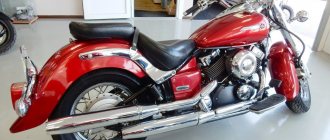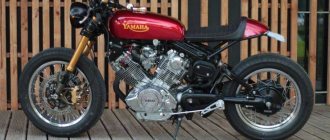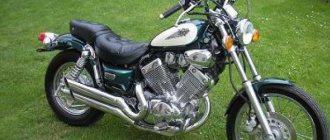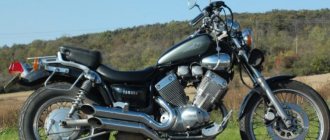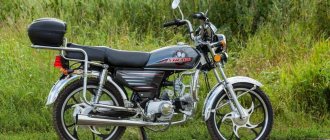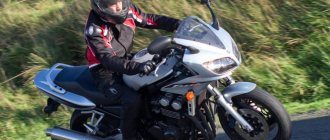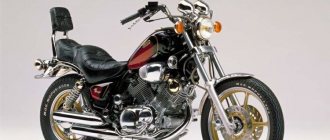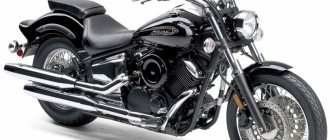Officially, the release date of the Yamaha Virago 400 is considered to be 1988. Years later, it no longer matters which of the Viraga models was born first - the 535th, an export “American”, or the training 400, intended exclusively for domestic Japanese use. The differences between these versions are only in cubic capacity. Otherwise they are almost identical. In Russia, it is the Virago 400 that is especially popular among novice bikers. Many girls give preference to the “Witch” - this is how the name of this miracle sounds in Russian. Due to what characteristics is this bike still in demand outside of Japan? This is largely due to the initial tasks facing the designers and further transformations.
Specifications
Technical characteristics of Yamaha XV750 Virago:
| Model | Yamaha XV750 Virago |
| Motorcycle type | cruiser |
| Year of issue | 1981-1998 |
| Frame | steel backbone (engine – load-bearing part) |
| engine's type | 2-cylinder, 4-stroke, V-shaped |
| Working volume | 748 cm³ |
| Bore/Stroke | 83.0 x 69.2 mm |
| Compression ratio | 8.7:1 |
| Cooling | air |
| Number of valves per cylinder | SOHC, 2 valves per cylinder |
| Fuel supply system | carburetor, 2x Mikuni BST40 |
| Ignition type | transistor TCI |
| Maximum power | 60.0 hp (44.0 kW) at 7000 rpm - XV750 (1981-1985) 55.0 hp (41.0 kW) at 7000 rpm – XV750 (1986-1998) |
| Maximum torque | 64.7 Nm (6.6 kg-m) at 6000 rpm - XV750 (1981-1985) 59.0 Nm (6.0 kg-m) at 6000 rpm - XV750 (1986-1998) |
| Clutch | Multi-disc in oil bath, cable drive |
| Transmission | 5-speed |
| type of drive | cardan |
| Front tire size | 100/90-19 (57H) |
| Rear tire size | 140/90-15M/C (70H) |
| Front brakes | 2 discs, 282 mm, 2-piston calipers – XV750 (1981-1993) 2 discs, 298 mm, 2-piston calipers – XV750 (1994-1998) |
| Rear brakes | drum |
| Front suspension | telescopic fork (non-adjustable), travel – 150 mm |
| Rear suspension | pendulum with monoshock absorber, stroke – 100 mm – XV750 (1981-1983) pendulum with two shock absorbers, stroke – 97 mm – XV750 (1984-1998) |
| Motorcycle length | 2230 mm – XV750 (1981-1983) 2285 mm – XV750 (1984-1998) |
| Motorcycle width | 850 mm – XV750 (1981-1983) 840 mm – XV750 (1984-1998) |
| Motorcycle height | 1160 mm – XV750 (1981-1983) 1190 mm – XV750 (1984-1998) |
| Wheelbase | 1525 mm |
| Seat height | 715 mm |
| Minimum ground clearance (clearance) | 145 mm |
| Acceleration to 100 km/h | 5.4 sec |
| Maximum speed | 168 km/h |
| Gas tank capacity | 14.5 l (including reserve - 2.5 l) |
| Motorcycle weight (curb) | 235 kg |
Reviews from Irbis Virago 110 owners
Almost a dream motorcycle, or “cheaper only on foot.” But seriously, a normal moped for the money is better than a stool. I bought it new back in 2014, and I still ride it sometimes, although I already have another bike. The Virago snow leopard is located in the village, and riding around on business is just the thing. After wintering in an unheated garage, it starts easily, although not on the first try. Oddly enough, it doesn’t break, although there are enough small jambs. The paint from the tank can be torn off with a fingernail, the speedometer died at around 860 km, the original chain was stretched to its limit after 3000 km. Arseniy, Krasnoznamensk, Irbis Virago 110 '2014
You can look at this Chinese fiend if your goal is to buy something alive for the price of a used Lada engine. It doesn’t eat gasoline, it sniffs it, it weighs less than me, traffic police officers don’t notice it at all. It drives reluctantly, after 60-70 kph the acceleration is slow. The brakes are so-so, the standard tires are terrible even by Chinese standards. The rest is okay, to be objective, the moped is worth the money. Sergey, Kovel, Irbis Virago 110 '2014
A normal utilitarian toy for every day, simple and not breakable. Does its job, maintenance is cheap, tuning like a new headlight is normal or there are panniers on Ali, it costs some garbage. Learning to drive is the best thing; the Irbis costs less than the Urals. Semyon, Sergiev Posad, Irbis Virago 110 '2015
Technical features of Virago 400
How is the 400cc Yamaha Virago motorcycle different from other choppers?
Air-cooled V-twins have one common problem - the rear cylinder often overheats. But, examining numerous reviews on the Yamaha Virago 400, there is no mention of overheating. Thanks to the large camber and the displacement of the second cylinder to the side, air circulates freely between the heads and effectively cools the engine. The power unit is stable even in extreme situations. Even bad gasoline can’t stop you from moving forward. The cardan transmission, which came to replace the chain a year after the start of production, only simplified operation. The reliability of the cardan became the calling card of the “Witch,” destroying many stereotypes. The annual replacement of fluids in the gearbox is all care and maintenance.
User Feedback
As the owners note, 400 cc on the Virago is quite enough to make the bike one of the most powerful in its class. Users often compare the motorcycle with the legendary Harley-Davidson. Special attention should be paid to the exhaust system.
Reviews of the Yamaha Virago 400 indicate that the exhaust unit allows you to reduce about 80% of the sound produced. The design consists of cylinder pipes that converge into a common resonator tank located at the very bottom of the machine. Then one pipe goes to the mufflers from the resonator. This design not only provides an original sound, but also makes it possible to correct the low center of gravity of the entire motorcycle. It is worth noting that the weight of the exhaust system is about 15 kilograms.
Design features
Legendary handling and maneuverability are achieved not only by the low location of the second gas tank. The front fork is designed with a minimum offset, which allows you to avoid creases when cornering.
From the outside it seems that all Viraga’s units are floating in the air. In fact, the parts are mounted on a tubular frame. The front suspension is reliable. A simple telescopic fork confidently holds the road and “swallows” potholes. A simple double-sided swingarm and shock absorbers make up the rear suspension.
The bike is compact in size, but reading reviews of the Yamaha Virago 400, there are owners taller than 175 cm. Many install additional footpegs or lower the gear foot for more comfortable control. The standard ground clearance is enough to overcome holes and obstacles. Viraga feels great on dirt roads and adequately “carries” a passenger if its dimensions are within reason.
The Yamaha Virago 400 model has not only the technical characteristics that ensure such popularity - it has a number of minor drawbacks. Studying the forums of fans of the Yamaha model, the Virago 400 model, I often come across reviews about the unstable operation of the electrical part. The weak point is the generator and charging relay. Therefore, the main condition for a successful trip, especially over long distances, is a high-quality battery. Some noise that characterizes the operation of an air-cooled engine becomes familiar after just a few days of use.
Another feature of the Yamaha 400 was a slightly increased oil consumption. It is due to thermal clearances that are larger than those on water-cooled engines. Adding oil should not be considered a problem. These are just design features of the motorcycle.
The light weight of the Yamaha Virago 400 - 180 kg and other technical characteristics, such as a standard convenient 5-speed gearbox in a coupe with a small wheelbase - is an ideal combination for beginners in the two-wheeled world and girls. Judging by the reviews, many endow “The Witch” with special qualities.
Another drawback is that the brakes are rather weak at high speeds and are not conducive to fast driving, because despite its small volume, the Virago has excellent acceleration dynamics. The Yamaha Virago 400 offers technical characteristics unusual for a cruiser: instant acceleration and the ability to enter an almost controlled skid.
After many years, Virago is distinguished by the best price-quality ratio on the secondary market and comfortable ergonomics.
https://youtube.com/watch?v=uRntUksw1Kg
Specifications
| Power: | 40 HP |
| Torque: | 34 Nm at 7000 rpm Nm |
| Engine type (cylinder arrangement): | 2-cylinder, V-engine, 4-stroke |
| Number of cylinders: | 2 |
| Engine capacity: | 399 cm3 |
| Cooling type: | Air |
| Transmission: | mech., 5-speed |
| Drive unit: | cardan shaft |
| Frame: | Steel |
| Weight: | 178 kg – dry. 199 kg - equipped. kg |
| Tank capacity: | 14 l. |
| Maximum speed: | 140 km/h |
| Wheelbase: | 1520 mm |
Suspension and transmission
The front fork is equipped with thin stays measuring 35 millimeters, which curl under active control and heavy braking. In conditions of frequent driving with a passenger, the silent blocks of the rear shock absorbers wear out actively, since the suspension is too soft for paired movement. The unit in question can be strengthened by installing gas-filled analogues.
The Yamaha 400 series chopper is equipped with a reliable five-range gearbox. True, some users note the difficulty in terms of softness of gear shifting.
Video
Virago XV 400
– this motorcycle is very popular among novice bikers, not least because of its affordable price.
A living device can be purchased for 100 thousand rubles, or even less if you’re lucky. Of all the 400 cc classmates, the Virago 400 is one of the most peppy bikes. Thanks to its low weight (about 150 kg) and 40 hp. it is very, very dynamic at speeds from 0 to 100 km/h. After a hundred, of course, it begins to quickly deflate, and finally refuses to accelerate when the speedometer marks 140 km/h. The heart of the XV 400 is a 2-cylinder v-shaped air-cooled engine, which is not picky about fuel quality. The author of this text, who at one time rode a Virago 1100, once personally poured 76 gasoline into the tank for lack of anything else, and nothing, the motorcycle withstood this mockery. The Virago cardan drive is reliable, as always (only the youngest Viragos - 125cc and 250cc versions - were produced with a chain drive). It is also worth mentioning that the Virago XV 400 was produced in two versions, the first of which had only one gas tank under the saddle. The Virago 400-2 has a small second gas tank instead of a false tank. This, by the way, is also true for Virago XV 535 of various years of production.
Both of the above-mentioned “witches” are built on the same base, and differ mainly only in the cylinder-piston group. If desired, the 400 cc Yamaha Virago can be converted into a 535 cc one. But the meaning of such tuning is a big question due to its tangible cost, which will never be repaid if the motorcycle is resold. Although if you manage to buy a used motor at a motor disassembly site, the final price of tuning may not be so high. In addition, if the arms grow from the right place, and their curvature does not exceed the statistical average, you can cope with replacing the motor yourself, calling your comrades for help.
The younger Yamaha Virago - 125 and 250 - are similar to each other and very different from the 400/535 and 750/1100 versions. They have their own frame and chain drive, while all other Virags have a cardan drive. Outwardly, all “Witches” are similar to each other, at least in general terms, but they all have the same style
So if you started with the youngest motorcycles in this series, and you liked them, then you should pay attention to the larger models. It's the same thing, only bigger and better
And starting to get acquainted with choppers with a Yamaha Virago 125 or 250 is a good idea if you can find them on sale. Small and light, they will be an excellent “study desk” for a beginner. Although the prices for the 400 cc version are not that much different, so perhaps it’s worth thinking about the XV 400 right away.
The older Yamaha Virago models share a different platform and, like the 400/535 versions, differ from each other mainly in the CPG.
Interesting Facts
Below is a brief history of the creation and development of the motorcycle:
- The production of the Virago 400 series, built on the basis of the American 535 version, began in 1988.
- In 1989, the bike was equipped with an additional 4.5-liter tank, and the seat was divided into two parts, from which the passenger seat could be removed. Providing access to the glove compartment.
- On the steering column. The engine cover and carburetor are replaced with aluminum parts with chrome-plated analogues.
- In 1996, a modification known as “Yamaha Drag Star” was released.
- Completion of production - 1998
Virago 400 version
Later, in 1987, the company released two more models of the Virago line - the export XV-535 and the domestic XV-400 model, which subsequently began to be sold in other countries.
It is the 400 cc “Witch” (that’s how “Virago” is translated) that will be discussed.
The XV-400 was in production until 1998, after which it was replaced by the Drag Star generation with its 400 cc model.
But the XV-400 is still in demand, and it is positioned by its nature as a motorcycle for beginners.
Despite its modest volumetric figures, the Virago 400 is fully consistent in appearance with American-style “cruisers”.
Low seating, small teardrop-shaped tank, high steering wheel and a large number of chrome elements.
Due to the slightly protruding fork forward, which is more typical of classic bikes, the Virago 400 has excellent handling and maneuverability.
Estimated cost
The Virago 400's attitude towards motorcycles for beginners lies in its characteristics.
The small engine has acceptable power for a beginner , a low center of gravity and a small wheelbase provide excellent handling.
Production of the Virago 400 has long been discontinued, but they are available on the secondary market and are in demand among novice motorcycle owners, since in addition to good technical characteristics, these motorcycles are also relatively inexpensive .
The simplicity of the design of this bike significantly affects reliability and maintainability.
The cost varies from 90 to 160 thousand rubles.
We offer you a review of another bike for beginners - the Honda Shadov 400, because it looks solid and its technical indicators are moderate.
This article disassembles a 400 cc motorcycle from Kawasaki:
Brief history of the model
Model
: Yamaha XV250 Route 66 / Virago (USA, Europe).
Factory designation
: XV250U; 3DN1.
Model
: Yamaha XV250 Route 66 / Virago (USA, Europe).
Factory designation
: XV250W; 3LU1, 3LS1, 3LW1, 3DN2.
Model
: Yamaha XV250 Route 66 / Virago (USA, Europe).
Factory designation
: XV250A; 3DN3.
Model
: Yamaha XV250 Virago (Japan, Europe).
Factory designation
: 3DM5, 3DM6, 3LS1.
Model
: Yamaha XV250 Virago (Japan, Europe).
Factory designation
: 3DM7, 3DM8, 3LS2, 3LW2, 3LU2.
Model
: Yamaha XV250 Virago (Japan, Europe).
Factory designation
: 3DM9, 3DMA, 3DMB, 3DMC, 3DN4, 3LS5, 3LS6, 3LU3, 3LW3.
Model
: Yamaha XV250 Virago (USA, Europe).
Factory designation
: XV250G; 3LW4, 3LW5, 3LS7, 3LS8, 3LS9, 3DN5, 3LU4, 3LU5.
Model
: Yamaha XV250 Virago (USA, Europe, Japan).
Factory designation
: XV250H; 3LW6, 3SLB, 3LU6, 3LSC, 3DN6; 3DMF, 3DMD, 3DME.
Model
: Yamaha XV250 Virago (USA, Europe, Brazil).
Factory designation
: XV250J; 3LW8, 3LSJ, 3LU8, 3LSH, 3DN7; 4XT1.
Model
: Yamaha XV250 Virago (USA, Europe).
Factory designation
: XV250K; 3LW9, 3LU9, 3LSL.
Model
: Yamaha XV250 Virago (USA, Europe).
Factory designation
: XV250L; 3LWA, 3LSM, 3LUA.
Model
: Yamaha XV250 Virago (USA).
Factory designation
: XV250M.
Model
: Yamaha XV250 Virago (USA).
Factory designation
: XV250N.
Model
: Yamaha XV250 Virago (USA).
Factory designation
: XV250P.
Model
: Yamaha XV250 Virago (USA, Europe).
Factory designation
: XV250R; 2UJD.
Model
: Yamaha XV250 Virago (USA, Europe).
Factory designation
: XV250S; 2UJH.
Model
: Yamaha XV250 Virago (USA, Europe).
Factory designation
: XV250T; 2UJK.
Model
: Yamaha XV250 Virago (USA, Europe).
Factory designation
: XV250V; 2UJP.
Model
: Yamaha XV250 Virago (USA, Europe).
Factory designation
: XV250W1; 2UJT.
Model
: Yamaha XV250 V-Star (USA, Europe).
Factory designation
: XV250XR; 2UJW.
Model
: Yamaha XV250 V-Star (USA, Europe).
Factory designation
: XV250YR; 46B2.
Model
: Yamaha XV250 V-Star (USA, Europe).
Factory designation
: XV250ZB; 46B4.
Model
: Yamaha XV250 V-Star (Europe).
Factory designation
: 46B6.
Model
: Yamaha XV250 V-Star (USA, Europe).
Factory designation
: XV250BB; 46B8.
Model
: Yamaha XV250 V-Star (USA, Europe).
Factory designation
: XV250D; 46BA.
Model
: Yamaha XV250 V-Star (North America, Australia).
Factory designation
: XV250EW, XV250ER, 46BC.
Model
: Yamaha XV250 V-Star (North America, Australia).
Factory designation
: XV250FL, XV250FB, 46BF.
Model
: Yamaha XV250 V-Star (North America, Australia).
Factory designation
: XV250GW, XV250GR, 46BJ.
Model
: Yamaha XV250 V-Star (North America, Australia).
Factory designation
: XV250HS, 46BM.
Model
: Yamaha XV250 V-Star (North America, Australia).
Factory designation
: XV250JB, 46BR.
Model
: Yamaha XV250 V-Star (North America, Australia).
Factory designation
: XV250K1.
Model
: Yamaha XV250 V-Star (North America, Australia).
Appearance
The Yamaha XV 400 Virago looks elegant. The spoked wheels are elegant. The working parts of the bike look extravagant when viewed from the front. The gas tank is small in appearance and somewhat flattened, which makes the bike even more sophisticated. Large rectangular mirrors and a distinctive chrome exhaust pipe complete the look.
The front main headlight, as well as the turn indicator lights, are made in the old style. So in terms of aesthetics, this is probably one of the best cruisers. And given current trends, it is unlikely that anything as sophisticated in this class will emerge in the future. Unless the trend becomes a return not only to retro classics, as now, but to retro cruisers.
Similar models
- Racer Trophy 110. It costs a little more than the Irbis Virago, but not much, and in terms of technical characteristics it is almost the same.
- Yamasaki Leader 110 . Another budget two-wheeled craft, not much different from the other two brothers in the model range - Yamasaki Scorpion 110 and Cobra 110
- Lifan LF125-5 . Outwardly it looks like the twin brother of Irbis Virago. In terms of performance characteristics it is also very similar to it.
- Wels Alpha 110 . Another budget utilitarian “Chinese”, nothing particularly remarkable.
Tuning and customization
Yamaha Virago is a tasty morsel for every customizer. Experts note that this is a very rewarding material that is pleasant to work with. This is largely due to the wide range of additional stages that the manufacturer itself offers.
With the help of small upgrades you can completely change the appearance of the Yamaha Virago bike. The photo of the tuned “Witch” allows you to verify this.
In the photo above, the steering wheel of the model was replaced, the exhaust pipes were re-welded, some changes were made to the body kit, wheels, and brake system. The deep black color, as usual, looks luxurious and expensive.
Some enthusiasts go even further, modernizing Virago to suit their own needs and creative impulses: they weld strollers, hang them with panniers, and even assemble powerful trikes from them.
Yamaha motorcycle: price
The modification in question has not been produced for more than 15 years. It can only be purchased on the secondary market. The price of a Yamaha motorcycle depends on the condition of the car, as well as the kilometers traveled. The average cost of a bike on the domestic market will be at least 100 thousand rubles.
Many owners and experts note that it is not so difficult to find even a model released more than two decades ago, the condition of which can be equated to ideal. The most popular are the 400 and 535 versions. Overall, the motorcycle is great for professionals and beginner motorcyclists.
"Witch"
Most fans of the model are sure that the word “Virago” translates as “Witch”. The image of a free, brave and beautiful sorceress flying in the night seems simply magical. And it fully matches the appearance and performance characteristics of the Yamaha Virago motorcycle. However, the original meaning of this word is somewhat different. It is translated as “masculine woman,” as evidenced by any dictionary. The creators put into the motorcycle the image of a stern warrior rather than a pretty witch.
And the name turned out to be suitable. “Virago” is endowed with a masculine character, excellent endurance and unprecedented strength.
Yamaha Virago 400: technical specifications
Below are the main parameters of the technical plan of the motorcycle in question:
- Type – cruiser (chopper).
- Years of production: 1988-1998.
- Frame material – steel.
- The power unit is a V-shaped two-cylinder four-stroke engine.
- Engine capacity is 399 cubic centimeters with a power of 40 horsepower.
- Compression – 9.7.
- Cooling type – atmospheric system.
- Fuel supply - carburetor.
- Maximum torque – 7 thousand rotations per minute.
- Drive – cardan shaft.
- Brakes: disc front, drum rear.
- Suspension: telescopic fork with 150 mm travel.
- The rear suspension is pendulum type with a double shock absorber.
- Length/width/height – 2.22/0.72/1.11 m.
- Wheelbase – 1.52 m.
- The speed limit is 135 km/h.
- Acceleration to 100 km – 7.5 seconds.
- The curb weight of the Yamaha Virago 400 motorcycle is 199 kg.
- Tires – 3.0-19/140-90-15.
Peculiarities
The main feature of the bike in question is a two-cylinder V-shaped air-cooled power unit. It produces 40 horsepower and 34 Nm of torque. The motor is adjusted for smooth traction in all ranges with a maximum speed of up to 8.5 thousand rotations per minute.
In addition, the modification is distinguished by a high-strength steel frame in a classic design, as well as a five-speed informative gearbox and 19/15-inch wheels. The package includes a front disc brake, telescopic front forks, dual rear shock absorber and driveshaft.
What do the owners say?
Many people are interested in the driving performance of this model. One review colorfully describes how a man tried to ride this bike in the outback, including on rural roads. The result is not the most rosy - I had to look for spare parts. So it's clear that, like most in this class, this bike is designed for the trail and nothing else.
Owners of this and other old bikes are advised to calculate before purchasing how much servicing of such equipment will ultimately cost. A new XV 400 Virago is no longer available, and used ones are usually in questionable condition
First of all, it is important to pay attention to the rear brake, because it is with this that problems most often arise after a serious mileage.
Judging by the reviews, the car is well suited for traveling from one city to another. Stability on the highway is noted. They say that traveling short distances within civilization on this motorcycle is a pleasure.
According to those who have ridden in different weather conditions, the bike performs best in dry weather. They also note that the car is stable in strong winds
This is important when traveling on a highway somewhere in the steppe.
Pay special attention to storage conditions
The car will already be worn out to some extent, and it is important to treat it with special care.
In conclusion, it is worth noting that the Yamaha XV 400 Virago is a very beautiful bike, but it is far from the most practical and safe. However, if beauty in technology and its age are paramount, then connoisseurs will certainly be pleased with such an acquisition.
Budget class in Chinese
If you put cheapness at the forefront and assemble a finished motorcycle from the simplest components, you will get something like the Irbis Virago 110. The technical characteristics of this bike are superior to any 50 cc moped, with the exception of sports versions, and in price it is no different from them. Perhaps the cost is its main advantage, because everything else is quite difficult to count as advantages. Although we can also mention the design simplicity, thanks to which any beginner can cope with the maintenance and repair of the Irbis Virago 110, and in financial matters this bike, as they say, will not fit into your pocket.
Chinese designers simply took a simple steel frame, placed a 110 cc air-cooled engine , a carburetor, an archaic 4-speed gearbox and called it all Irbis Virago. What can this motorcycle do? Well, it can carry its owner around on errands, and for rural areas without much traffic, it is well suited. There is almost nothing to break in it, and spare parts cost pennies if you need them. The Chinese have even provided a trunk on which you can easily load an armful of hay or put a plastic trunk for small luggage.
The stated maximum speed of the Irbis Virago is 110 km/h, but in reality it is difficult to squeeze more than 80 km/h out of this motorcycle. And I don’t want to, to be honest, because at high speeds the parasitic vibrations are incredibly annoying. At peak power, the Irbis Virago 110 engine produces 6.5 horsepower . Of course, this is not enough, but with a dry weight of the bike of 81 kg , it is quite enough for even a 100-kg guy to ride comfortably. In this case, the lack of power will be felt only when driving uphill. Of course, the presence of a passenger has the most detrimental effect on the dynamics and effectiveness of the brakes - a heavily loaded Irbis Virago does not want to either accelerate or brake. What to do - budget category. But the motorcycle is controlled by the power of thought, and the rigid and uncomfortable suspension, according to reviews from owners, is characterized by amazing survivability.
Video
Yamaha Virago XV 1000
- a motorcycle produced back in the 80s. It belongs to the Virago series, and is a kind of hybrid between the 750 cc and 1100 cc versions of this motorcycle.
Due to their age, these motorcycles are now rarely seen, like even older 920 cc versions, and at the same time the XV 1000 shares common features with the 700cc, 750cc, 920cc, and 1100cc Viragami. There are actually few structural differences, but they still exist.
The main difference is that the XV 1000 had a crankshaft from the 700/750/920 cc versions, which was different from the crankshaft of the 1100 cc version. In addition, the pistons also differ - on 700-1000 cc Viragos the piston diameter is 92 millimeters, and on the Yamaha Virago 1100 - 95 millimeters. Thanks to a shorter stroke shaft with the same cylinder-piston group, the XV 1000, oddly enough, produces better performance in both maximum power and torque than the 1100cc. True, you have to pay for this with slightly less thrust in the lower rev range (again, compared to 1100cc; the XV 1000 still has this figure better than all the younger versions). Perhaps this was the reason why the XV 1000 did not last long on the assembly line.
Externally, the XV 1000 is practically no different from the 750/1100cc Virag, which themselves differ only in the piston, not counting other minor differences. One of the features of the XV 1000 is the standard Hitachi carburetors (the same ones were installed on the XV750), which are notorious for their capricious behavior and the total lack of repair kits for them. However, this can be corrected by purchasing and installing Mikuni carburetors from older versions of the XV1100.
Otherwise, these motorcycles are 99% structurally similar, and the owner of the XV 1000 will not have problems finding spare parts and consumables, despite the fact that the Virago series has been out of production for a decade and a half. There were a lot of these motorcycles produced, and they are still popular, so there is quite enough both tuning and spare parts for them. Accordingly, one hundred percent of all components and parts will fit on the XV 1000 from either its 750cc or 1100cc counterparts.
Pros and cons of Irbis Virago 110
Advantages
- Price! Even a new Irbis Virago can be bought cheaper than a normal bicycle, and used copies are even cheaper.
- Tuning . Irbis Virago has a surprising amount of it, and you can order it directly from Aliexpress .
- Cost of maintenance . Both consumables and spare parts are very cheap. Sometimes it’s so cheap that you can’t even believe it.
- Simplicity . Armed with a manual and a budget set of tools, you can disassemble and reassemble the Irbis Virago in half a day
- Fuel consumption . The bike readily consumes AI-92 (perhaps it will also run on AI-80, but we haven’t had a chance to check it personally), and it consumes 2-2.5 liters per 100 km .
Flaws
- Standard headlight . It shines about as brightly as an LED flashlight on a Chinese smartphone.
- Brakes . Only the disc brake on the front wheel works more or less tolerably, and the rear “drum” is of little more than zero use.
- Pendants . They may be hardy, but they are weak, and under a strong Russian motorcyclist the Irbis Virago 110 immediately sags noticeably, and on road bumps the shock absorbers easily break through
- Gas tank volume . As much as 6.5 liters is, of course, very respectable. Probably, increasing the volume by even a couple of liters would make the model unimaginably more expensive.
- Appearance . Old bikers who still remember their first “Voskhod” or “Karpaty”, seeing the Irbis Virago 110, will certainly wipe away a stingy nostalgic tear.
Dimensions and weight
This is an average cruiser. The car looks large, but it cannot be compared in size with the largest representatives of the class. But regarding a motocross motorcycle, a sportbike or road motorcycles, the difference is immediately visible. Just one look at the photo is enough to make sure that this is a really large car.
The dimensions of the Yamaha XV 400 Virago are as follows:
- height – 1115 mm;
- width – 725 mm;
- length – 2225 mm;
- wheelbase – 1520 mm;
- saddle height – 720 mm;
- ground clearance – 160 mm;
- curb weight – 199 kg;
- Tank capacity – 13.5 l.
The ground clearance is quite high for a cruiser. So on not too bad roads the bike will not suffer and will pass this test with honor. However, the model is not suitable for off-road use, like any other cruiser. This is natural for the class, and there is nothing to complain about.
So you should use this and any other cruiser with caution, remembering that this is not a touring enduro
Exterior
The motorcycle in question is divided into two modifications. The first was produced with one tank located under the saddle. The updated version received a pair of fuel tanks, thanks to which the fuel supply increased to 13.5 liters. It is almost impossible to find a starting model with one fuel tank on the secondary market.
The supporting frame of the bike is durable and well-thought-out design. This solution allows for good controllability of the machine and partially compensates for the softness of the suspension fork.
Design Features
The design of the motorcycle is similar to the rest of the “Witches” line. All components of the bike are mounted on a tubular frame.
The front suspension consists of a simple telescopic fork, which ensures its reliability. At the rear there is a suspension in the form of a double-sided pendulum, also structurally simple, and two shock absorbers.
What’s noteworthy is that the first bikes from the “Witches” line were equipped with a monoshock absorber, but later they abandoned it.
The Virago 400’s tank is also interesting. On the first models aimed at the domestic market, the tank was located under the seat and had a volume of 8.6 liters, and a false tank was located on the frame in front of the seat.
After the decision to launch this model on the foreign market, the false tank was covered with a regular one, although the tank remained under the seat. This allowed the total volume of the tanks to be increased to 14 liters.
A feature of the location of the tank under the seat was a lower center of gravity, which had a positive effect on handling.
The power plant, like all “Witches”, in the XV-400 had a V-shaped cylinder arrangement, with the rear cylinder shifted to the side, which provided additional cooling.
The carburetor power system was located in the camber of the cylinders. The exhaust system, consisting of two pipes, exited to the right side.
The first 400 cc “Witches” had a chain drive, but with entry into the foreign market they began to install a driveshaft on it. The braking system consisted of front disc brakes and rear drum brakes.
The seat of the motorcycle was stepped. There was a tank under the driver's seat, and a small glove compartment for keys under the folding passenger seat. There was a backrest behind the seats.
The instrument panel was installed analog and was placed on the front fork near the steering wheel.
Tuning
As they say, there is no limit to perfection. So the owners of the Yamaha chopper are trying to improve the motorcycle in every possible way. An additional incentive is provided by the wide range of additional accessories that the manufacturer offers. Most often, changes concern the appearance of the “iron horse.” Users equip it with a body kit, updated mirrors, sensors and seats.
One of the most optimal tuning options is to replace the steering wheel, overcook the exhaust system, and install new brakes and wheels. Those owners who are tired of the standard color of the car repaint it in specialized workshops according to their taste and preferences. Some craftsmen manage to weld strollers, mount panniers, or make a more powerful variation out of an existing model by afterburning or replacing the engine.
Gas tanks and appetite
At first, the 535 was produced with one gas tank. It was located under the saddle. This made it possible to significantly reduce the center of gravity of the bike’s structure, which, of course, had a positive effect on its stability. Its capacity was 8.6 liters. Between the seat and the tidy there was a decorative false tank. Fuel was supplied to the engine not by self-stack, as in most motorcycles, but by means of a fuel pump.
Since 1986, the concept has changed, and in place of the decorative tank, another, real one, with a volume of 4.5 liters, appeared. This allows you to travel long distances without refueling.
Speaking about the appetites of the Japanese “Witch”, it is worth taking into account the year of manufacture and modification of the model, season, conditions, road surface. On average, at a cruising speed of 120 km/h on the highway, the Yamaha Virago will “eat” about 6 liters of gasoline. Of course, having a passenger and filled panniers will increase consumption.
Power point
The Yamaha Virago 400 model is equipped with a reliable and durable engine. Among the many advantages, owners highlight only one disadvantage of the engine. As practice shows, it does not have the best oil pan. The element is located very low, which contributes to its damage on uneven roads, up to the appearance of chips and cracks. Also, the series in question has problems with the starter bendix.
The Yamaha Drag Star motorcycle was first produced with a fuel tank that was placed under the seat. Its capacity was 8 liters. Fuel was supplied to the system using a gasoline pump. After 1989, a decorative tank appeared on modifications, and the volume of the main tank increased to 13.5 liters, thanks to the installation of an additional tank.
